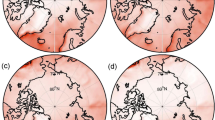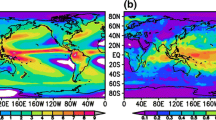Abstract
The interdecadal and the interannual variability of the global monsoon (GM) precipitation over the area which is chosen by the definition of Wang and Ding (Geophys Res Lett 33: L06711, 2006) are investigated. The recent increase of the GM precipitation shown in previous studies is in fact dominant during local summer. It is evident that the GM monsoon precipitation has been increasing associated with the positive phase of the interdecadal Pacific oscillation in recent decades. Against the increasing trend of the GM summer precipitation in the Northern Hemisphere, its interannual variability has been weakened. The significant change-point for the weakening is detected around 1993. The recent weakening of the interannual variability is related to the interdecadal changes in interrelationship among the GM subcomponents around 1993. During P1 (1979–1993) there is no significant interrelationship among GM subcomponents. On the other hand, there are significant interrelationships among the Asian, North American, and North African summer monsoon precipitations during P2 (1994–2009). It is noted that the action center of the interdecadal changes is the Asian summer (AS) monsoon system. It is found that during P2 the Western North Pacific summer monsoon (WNPSM)-related variability is dominant but during P1 the ENSO-related variability is dominant over the AS monsoon region. The WNPSM-related variability is rather related to central-Pacific (CP) type ENSO rather than the eastern-Pacific (EP) type ENSO. Model experiments confirm that the CP type ENSO forcing is related to the dominant WNPSM-related variability and can be responsible for the significant interrelationship among GM subcomponents.













Similar content being viewed by others
References
Adams DK, Comrie AC (1997) The North American monsoon. Bull Am Meteorol Soc 78:2197–2213
Adler RF, Huffman GJ, Chang A et al (2003) The version 2 Global Precipitation Climatology Project (GPCP) monthly precipitation analysis (1979–present). J Hydrometeorl 4:1147–1167
Ashock K, Behera SK, Rao SA, Weng H, Yamagata T (2007) El Niño Modoki and its possible teleconnection. J Geophys Res 112:C11007
Chen J, Gupta AK (2000) Parametric statistical change point analysis. Birkhauser, Basel
Ha KJ, Ha E (2006) Climatic change and interannual fluctuations in the long-term record of monthly precipitation for Seoul. Int J Climatol 26(5):607–618
Hsu P, Li T, Wang B (2011) Trends in global monsoon area and precipitation over the past 30 years. Geophys Res Lett 38:L8701
Kalnay E, Kanamitsu M, Kistler R et al (1996) The NCEP/NCAR 40-year reanalysis project. Bull Am Meteorol Soc 77:437–471
Kao HY, Yu JY (2009) Contrasting eastern-Pacific and central-Pacific types of ENSO. J Clim 22:615–632
Kitoh A, H Endo, KK Kumar, IFA Cavalcanti, P Goswami, T Zhou (2013) Monsoons in a changing world: a regional perspective in a global context. JGR. doi:10.1002/jgrd.50258
Kug JS, Jin FF, An SI (2009) Two types of El Niño events: cold tongue El Niño and warm pool El Niño. J Clim 22:1499–1515
Kwon MH, Jhun JG, Wang B, An SI, Kug JS (2005) Decadal change in relationship between east Asian and WNP summer monsoons. Geophys Res Lett 32:L16709
Lee JY, B Wang (2012) Future change of global monsoon in the CMIP5. Clim Dyn. doi:10.1007/s00382-012-1564-0
Lepage Y (1971) A combination of Wilcoxson’s and Ansari-Bradley’s statistics. Biometrika 58:213–217
Li H, Zhou T, Li C (2010) Decreasing trend in global land monsoon precipitation over the past 50 years simulated by a coupled climate model. Adv Atmos Sci 27(2):285–292. doi:10.1007/s00376-009-8173-9
Liu J, Wang B, Ding Q, Kuang X, Soon W, Zorita E (2009) Centennial variations of the global monsoon precipitation in the last millennium: results from ECHO-G model. J Clim 22:2356–2371
Pettitt A (1979) A non-parametric approach to the change-point problem. Appl Stat 28(2):126–135
Pettitt A (1980a) A simple cumulative sum type statistic for the change-point problem with zero-one observations. Biometrika 67:79–84
Pettitt A (1980b) Some results on estimating a change-point using nonparametric type statistics. J Stat Comput Simul 11:261–272
Rayner NA, Parker DE, Horton EB, Folland CK, Alexander LV, Rowell DP, Kent EC, Kaplan A (2003) Global analyses of sea surface temperature, sea ice, and night marine air temperature since the late nineteenth century. J Geophys Res 108:4407. doi:10.1029/2002JD002670
Roeckner E et al (2003) The atmospheric general circulation model ECHAM5, part I: model description. Max-Planck-Inst für Meteorol Rep 349:127
Trenberth K, Stepaniak D, Caron J (2000) The global monsoon as seen through the divergent atmospheric circulation. J Clim 13:3969–3993
Wang B, Ding Q (2006) Changes in global monsoon precipitation over the past 56 years. Geophys Res Lett 33:L06711
Wang B, Ding Q (2008) Global monsoon: dominant mode of annual variation in the tropics. Dyn Atmos Ocean 44:165–183
Wang B, Wu R, Fu X (2000) Pacific-east Asian teleconnection: how does ENSO affect east Asian climate? J Clim 13:1517–1536
Wang B, Wu R, Lau KM (2001) Interannual variability of the Asian summer monsoon: contrasts between the Indian and the western north Pacific-east Asian monsoons. J Clim 14:4073–4090
Wang B, Wu R, Li T (2003) Atmosphere-Warm ocean interaction and its impact on Asian-Australian monsoon variation. J Clim 16:1195–1211
Wang B, Yang J, Zhou T, Wang B (2008) Interdecadal changes in the major modes of Asian–Australian monsoon variability: strengthening relationship with ENSO since the late 1970s. J Clim 21:1771–1789
Wang B, Liu J et al (2012) Recent change of the global monsoon precipitation (1979–2008). Clim Dyn 39:1123–1135
Wang B, Xiang B, Lee JY (2013) Subtropical high predictability establishes a promising way for monsoon and tropical storm predictions. PNAS 110:2718–2722
Wu B, Zhou T, Li T (2009) Seasonally evolving dominant interannual variability modes of East Asian climate. J Clim 22:2992–3005
Wu B, Li T, Zhou T (2010) Relative contributions of the Indian Ocean and local SST anomalies to the maintenance of the western North Pacific anomalous anticyclone during El Niño decaying summer. J Clim 23:2974–2986
Yonetani T, Gregory JMC (1994) Abrupt changes in regional temperature in the conterminous United States, 1895–1989. Clim Res 4:13–23
Yu JY, Kao HY (2007) Decadal changes of ENSO persistence barrier in SST and ocean heat content indices: 1958–2001. J Geophys Res 112:13106
Yu JY, Kao HY, Lee T (2011) Subtropics-related interannual sea surface temperature variability in the equatorial central Pacific. J Clim 23:2869–2884
Yun KS, Seo KH, Ha KJ (2008) Relationship between ENSO and northward propagating intraseasonal oscillation in the east Asian summer monsoon system. J Geophys Res 113:D14120. doi:10.1029/2008JD009901
Yun KS, Seo KH, Ha KJ (2010) Interdecadal change in the relationship between ENSO and the intraseasonal oscillation in East Asia. J Clim 23:3599–3612. doi:10.1175/2010JCLI3431.1
Zhang L, Zhou T (2011) An assessment of monsoon precipitation changes during 1901–2001. Clim Dyn 37:279–296. doi:10.1007/s00382-011-0993-5
Zhang L, Zhou T, Wu B, Bao Q (2010) The annual modes of tropical precipitation simulated by the LASG/IAP coupled ocean-atmosphere model FGOALS_s1.1. Acta Meteorol Sinica 24(2):189–202
Zhou T, Zhang L, Li H (2008a) Changes in global land monsoon area and total rainfall accumulation over the last half century. Geophys Res Lett 35:L16707. doi:10.1029/2008GL034881
Zhou T, Yu R, Li H, Wang B (2008b) Ocean forcing to changes in global monsoon precipitation over the recent half-century. J Clim 21:3832–3852
Zhou T, Wu B, Scaife AA, Bronnimann S et al (2009) The CLIVAR C20C project: which components of the Asian-Australian monsoon circulation variations are forced and reproducible? Clim Dyn 33:1051–1068. doi:10.1007/s00382-008-0501-8
Zhou T, Hsu HH, Matsuno J (2011) Summer monsoons in East Asia, Indochina, and the western North Pacific. The global monsoon system: research and forecast, 2nd edn. World Scientific Publishing Co, Singapore, pp 43–72
Acknowledgments
This GRL work was supported by the National Research Foundation of Korea (NRF) grant funded by the Korea government (MEST) (No. 2011-0021927) in Korea.
Author information
Authors and Affiliations
Corresponding author
Appendix: Change-point detection methods
Appendix: Change-point detection methods
In this study, two methods were used for change-point detection. The Lepage test (Lepage 1971; Yonetani and Gregory 1994) is a non-parametric test that investigates significant differences between two samples, even if the distributions of the parent populations are unknown. The Lepage statistic, HK (symbol used by Yonetani and Gregory 1994), is combination of standardized statistics of Wilcoxon and Ansari-Bradley (Lepage 1971). If HK is greater than 5.99 or 9.21, the mean change between the two samples is significant at the 95 or 99 % confidence level, respectively.
The second methods is the Pettitt test (1979, 1980a). Pettitt derived the test statistic on the basis of changes in the median of the observation sequence by examining the rank of the observations. The Pettitt test uses a remarkably stable distribution and provides a stout test of the change-point resistant to outliers (Pettitt 1980b). The Pettitt test procedure is as follows:
First, each of the observations X 1, X 2, …, X N is ranked from 1 to N. Let r i be the rank associated with the observations X i . Then, at each place j in the series, we calculate
which is the sum of the ranks of the variables at or before point j. Next, for each point in the sequence, we calculate 2W j − j(N + 1) to set
The value of j where the maximum in K m,n occurs is the estimated change-point in the sequence and is denoted by m. The number of observations after the change-point is n = N − m. The sampling distribution of W m is normally distributed with mean m(N + 1)/2 and variance mn(N + 1)/12 when N is large. We then perform a statistical test to determine whether the estimated change-point m is significant by using the sampling distribution of W m .
Rights and permissions
About this article
Cite this article
Lee, EJ., Ha, KJ. & Jhun, JG. Interdecadal changes in interannual variability of the global monsoon precipitation and interrelationships among its subcomponents. Clim Dyn 42, 2585–2601 (2014). https://doi.org/10.1007/s00382-013-1762-4
Received:
Accepted:
Published:
Issue Date:
DOI: https://doi.org/10.1007/s00382-013-1762-4




